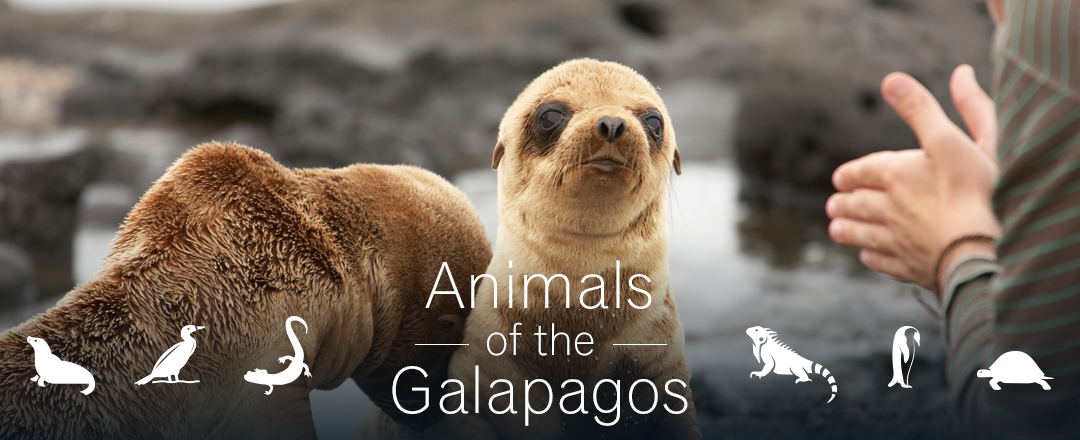We thus learn that man is descended from a hairy, tailed quadruped, probably arboreal in its habits, and an inhabitant of the Old World.
– Charles Darwin, The Descent of Man
From the land iguana, to the giant tortoise, to the blue-footed booby, the Galápagos islands are a haven for enthusiasts of all things fauna. Known as the place where Darwin researched and solidified his theory of evolution, they’re also home to some of the most unique species in the world, including some you won’t find anywhere else.
While you can always find pictures of them on the internet, nothing compares to seeing them in person. Take your nature obsession to the next level on one of our science tours. Until then, quench your curiosity with tidbits on ten of the Galápagos’ beloved animal inhabitants:
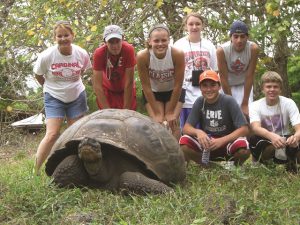
Giant tortoise (Chelonoidis nigra)
Perhaps the most famous species of the Galápagos, the giant tortoise is endemic, meaning they aren’t found anywhere else in the world.
With an average lifespan of over 100 years and the ability to go for a year without food or water, the tortoises were once prized by buccaneers, who would take them on ships for backup food in the 16th-17th centuries, leaving the tortoises a threatened species.
That hasn’t stopped them from becoming the islands’ mascot, though: The giant tortoise is so revered that it gave name to the Galápagos islands — the old Spanish word “galapago” means saddle, referring to the tortoise’s round shell.
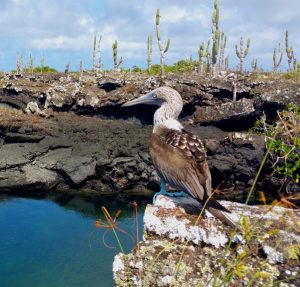 Blue-footed booby (Sula nebouxii)
Blue-footed booby (Sula nebouxii)
They’re not just for show: The blue-footed booby’s brightly coloured feet only appear on males, who use them to attract mates in a complex mating dance. The foot colour is also an indicator of health, with the level of brightness showing females how healthy the male suitor is.
One of the six species of subtropical marine birds known as boobies — including a red-footed variety, also found in the Galápagos — the blue-footed booby is known for having eggs that hatch at different times, rather than all at once. This makes for different-sized chicks that fight each other for resources, sometimes to the death.
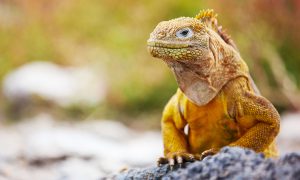 Galápagos land iguana (Conolophus subcristatus)
Galápagos land iguana (Conolophus subcristatus)
Another set of species that’s endemic to the Galápagos, the land iguana comes in bright yellow, and can live for up to 60 years. Cold-blooded, they can be found hanging out on volcanic rocks, where they get most of their heat.
And if you’re really lucky, you’ll spot a pink one: Only 200 of these are left alive after becoming endangered due to introduced animals infringing on their territory.
Don’t expect them to be nice to look at, though. Despite their bright colours, Darwin called them “ugly.”
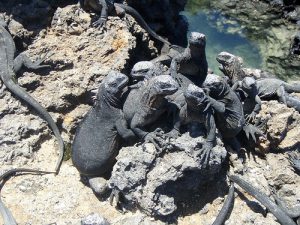
Marine iguana (Amblyrhynchus cristatus)
They go way back — the marine iguana shares a common ancestor with the land iguana, and both are only found in the Galápagos. In fact, the two species can actually interbreed, though their offspring are sterile.
The marine iguana is different from its land-locked cousin, though: It’s the only lizard in the world that feeds from the sea, eating mostly algae.
It’s also remarkable in its adaptations to stress. When there’s not enough food to go around, the marine iguana shrinks in size in order to use energy more efficiently.
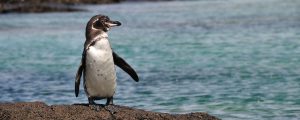 Galapagos penguin (Spheniscus mendiculus)
Galapagos penguin (Spheniscus mendiculus)
The only penguin found north of the equator and the second-smallest penguin species, the Galápagos penguins are some of the cutest critters you’ll find on the islands.
Another endemic species, they go to great lengths to stay cool, hunching over to protect their sensitive feet from sunlight, and keeping their eggs cool by hiding them between rocks.
You’d be lucky to spot one, though: Unfortunately, it’s estimated that there are only about 1500 of these penguins left, with 70% of its population lost in the 1980s due in part to introduced dogs and cats.
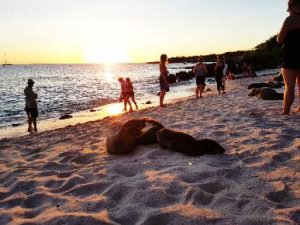 Galápagos sea lion (Zalophus wollebaeki)
Galápagos sea lion (Zalophus wollebaeki)
Known as the “welcoming party” of the Galápagos islands, these friendly and playful animals are often seen lounging on beaches as visitors come in.
Endemic to the Galápagos, the Galápagos sea lions are well-known for their “bark;” incredibly, a mother and her calf can distinguish each others’ barks from 30 other sea lions.
Females can be found babysitting groups of pups while other females hunt far away. Look out for battle scars on the males: They are very territorial, and often get into fights.
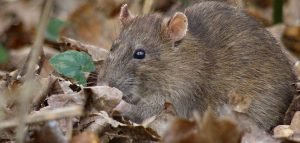 Rice Rat (Aegialomys galapagoensis)
Rice Rat (Aegialomys galapagoensis)
They may not sound remarkable, but these little rats, endemic to the Galapagos, have accomplished an astonishing feat. Many animals arrived at the Galápagos from mainland South America, but rice rats actually hold the world record for the longest unaided ocean crossing for any mammal.
While the ancestors that made the crossing, giant rats, used to roam the island, you can rest easy knowing that they’re extinct, and the current rice rats are nocturnal. In fact, most travellers don’t see them at all.
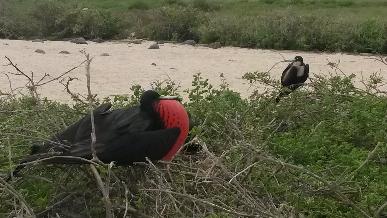 Great frigatebird (Fregata minor)
Great frigatebird (Fregata minor)
Known for its red-purple neck feathers, which males expand during mating season, these massive birds have an incredible 7-foot wingspan.
They put it to good use, too — great frigatebirds travel hundreds of miles away from home, but always return to where they were born to lay eggs. Speaking of eggs, their chicks can be heard calling and tapping before they’ve hatched.
As if that wasn’t weird enough, great frigatebirds have also been known to steal food from other birds while in the air, a practice known as kleptoparasitism.
Sally Lightfoot Crab (Grapsus grapsus)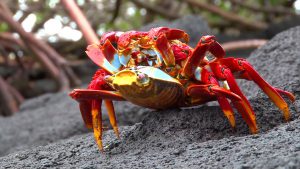
These brightly coloured crabs are nice to look at, but don’t bother trying to catch them — as Darwin noted when he visited the island, they’re notoriously fast.
They also don’t work well as food, and are instead mostly used by fisherman as bait. They serve an important purpose on the island, though: They clean the parasites off of marine iguanas in an instance of symbiosis.
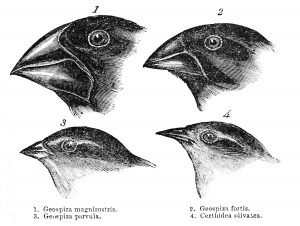 Darwin’s finches (Thraupidae family)
Darwin’s finches (Thraupidae family)
Actually a group of 15 species of birds, “Darwin’s finches” are partly responsible for inspiring the theory of evolution.
Darwin originally captured the finches on the second voyage of the Beagle. Seeing that the different species were all very similar to American finches, except with different sized and shaped beaks, Darwin determined that the birds had “diverged” from their American ancestor, evolving different traits to adapt to their new environment.
This includes one sharp-beaked ground finch, known as the “vampire finch” for sucking the blood of other animals. See if you can spot a finch perched on the back of a giant tortoise — they eat parasites off the shells.
If you’re excited to show off these animals to your students, you’re in luck: We have many tours that either focus on the islands or include excursions there. Choose from The Galápagos & Machu Picchu, Ecuador: Andes & Amazon Adventure (Galápagos tour optional), Galápagos Island Adventure, Galápagos Island Highlights, and Make a Difference: Ecuador (Galápagos tour optional).
Works cited:
https://www.galapagos.org/about_galapagos/about-galapagos/biodiversity/mammals/
https://en.wikipedia.org/wiki/Gal%C3%A1pagos_Islands
http://travelblog.goaheadtours.com/9-animals-youll-only-find-in-the-galapagos/

